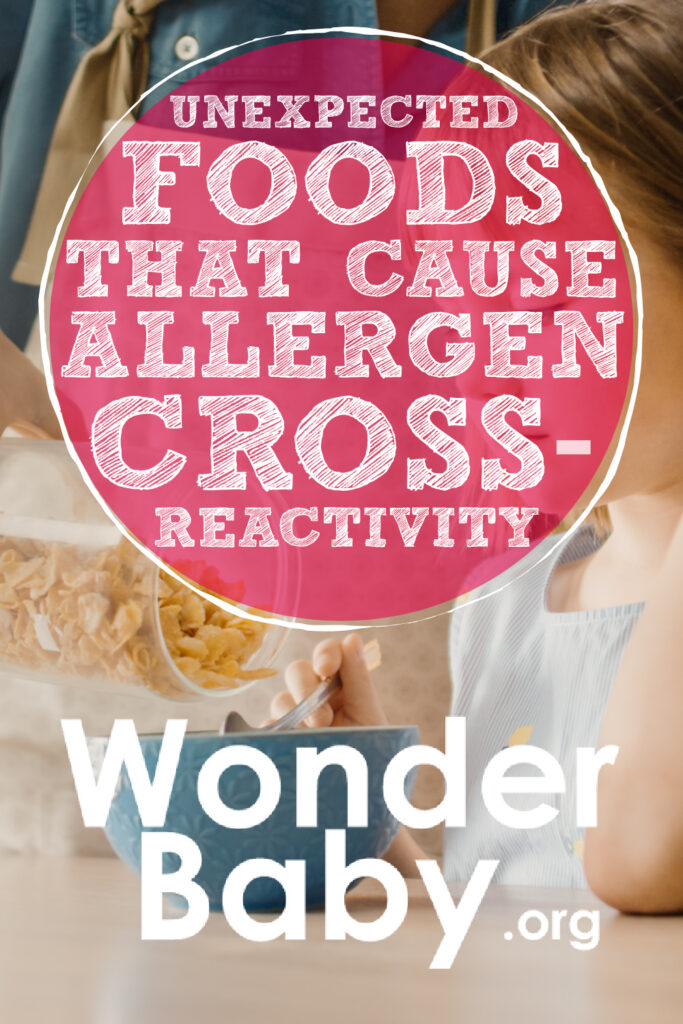Unexpected Foods That Cause Allergen Cross-Reactivity

- Structurally related foods can cause an allergic reaction.
- Cross-reactive proteins can be found among fruits, vegetables, and all food groups included in the top nine allergens.
- Environmental allergies can also cause clinical cross-reactivity with food allergies.
- There are many strategies available to help you manage allergen cross-reactivity.
Should people with an egg allergy avoid eating turkey? Might your child’s peanut allergy affect their ability to sample Great-Aunt Martha’s green bean casserole? Could your allergic rhinitis (hay fever) have anything to do with the fruit salad you sampled?
You may be surprised to learn that the answer to all of the above is yes.
But how are these foods related? The answer lies in the concept of allergen cross-reactivity.
Severe allergic reactions can be caused by cross-reactivity among food groups. In its simplest form, allergen cross-reactivity speaks to the ability of different foods to carry similar proteins, which can signal a strong immune response, causing a variety of allergic diseases—including asthma and food allergies.
When your healthcare provider is diagnosing specific allergies through skin prick tests or oral food challenges, they will work with your family to identify a number of unexpected foods and substances that can cause allergen cross-reactivity.
Read on to learn about the surprising ways cross-reactive food proteins can show up in your daily life.
Understanding Allergen Cross-Reactivity

To best understand the biological processes behind cross-reactivity, let’s briefly review the science.
Cell Proteins
All living things contain proteins—within the human body, they’re the means by which cells send messages to each other. Foods and substances within the environment, like pollen and dust mites, have proteins too.
For the general population who doesn’t have a food allergy, proteins inside and outside the body encounter each other and no reaction occurs. However, individuals with food allergies are considered atopic11. About Atopic Disease. American Academy of Pediatrics. 2023. https://www.aap.org/en/patient-care/atopic-dermatitis/about-atopic-disease/#:~:text=Atopy%20is%20the%20genetic%20predisposition,to%20otherwise%20harmless%20environmental%20substances., which means their bodies are genetically more likely to produce an increased response when presented with exposure to their allergens.
Cellular Response to Allergens
Now, let’s say an atopic person has an unknown allergy to peanuts and tree nuts, and then eats from a container of mixed nuts. The proteins in the nuts interact with the cells in the body. The body responds with, “Oh no, we can’t have this! It’ll make us really sick!”
Enter a substance called allergen-specific immunoglobulin E (IgE)22. The Children’s Hospital of Philadelphia. IgE-Mediated Food Allergies. The Children’s Hospital of Philadelphia. 2014. https://www.chop.edu/conditions-diseases/ige-mediated-food-allergies. This substance normally floats around and deals with foreign invaders, like viruses or parasites, by releasing histamine, which is a good thing.
However, in our example, IgE sees the (normally nonthreatening) nut protein as a huge threat and releases a bunch of histamine to fight the offending protein. This will result in widespread symptoms throughout the body, which is why those experiencing severe reactions will see symptoms in multiple body systems.
This response to a food allergen is known in the medical world as an immediate reaction33. Abbas M, Moussa M, Akel H.. Type I Hypersensitivity Reaction. StatPearls Publishing. 2023. https://www.ncbi.nlm.nih.gov/books/NBK560561 or IgE-mediated food allergy44. Anvari, S., Miller, J., Yeh, C.-Y., & Davis, C. M.. IgE-Mediated Food Allergy. Clinical Reviews in Allergy & Immunology. 2018;57(2), 244–260. https://doi.org/10.1007/s12016-018-8710-3.
Cross-Reactivity
In IgE-mediated food allergy, the body recognizes a normally nonthreatening protein as a major threat and works to fight it.
It may surprise you to learn that different foods and environmental substances share chemically related proteins.
Imagine someone with a cow’s milk allergy who samples goat’s milk. With cross-reactivity, the body recognizes the similar protein structure of the goat’s milk as an equally serious threat to cow’s milk and produces the same strong reaction.
Even though the milk comes from two different mammals, the body responds in an identical way. The same is true of other cross-reactive situations.
Unexpected Culprits
Because all foods carry proteins, food allergies due to cross-reactivity occur across the spectrum of edible products, including unexpected sources like plant-derived foods.
Take a look at how a cross-reactivity allergy presents among the following groups:
Cross-Reactivity in Fruit and Vegetable Allergies

Have you ever experienced hay fever symptoms after eating specific raw fruits or vegetables? Have you then found that you could eat cooked forms of those foods without experiencing the same symptoms?
If so, you may be experiencing a phenomenon known as oral allergy syndrome (OAS).
Also known as pollen food syndrome or pollen food allergy syndrome, this condition occurs when an atopic person’s immune system responds to the cross-reactive proteins between pollen, plant foods like raw fruits or vegetables, as well as some types of tree nuts.
Interestingly, individuals with this syndrome are usually able to tolerate cooked forms of the offending product. For example, a person with an allergy to birch pollen and an apple allergy or peach allergy could likely tolerate an apple or peach pie because the heat of the cooking process results in the destruction of the responsible proteins.
Although not all patients who have pollen allergies will experience OAS, experts at the American College of Allergy, Asthma, and Immunology55. Pollen Food Allergy Syndrome. ACAAI Public Website. 2019. https://acaai.org/allergies/allergic-conditions/food/pollen-food-allergy-syndrome describe the following known associations between these groups:
- Birch pollen allergy: Apple, almond, carrot, celery, cherry, hazelnut, kiwi, peach, pear, and plum.
- Grass pollen allergy: Celery, melons, oranges, peaches, and tomatoes.
- Ragweed pollen allergy: Bananas, cucumber, melons, sunflower seeds, and zucchini.
Individuals with oral allergy syndrome can also experience anaphylaxis66. Anaphylaxis: A severe allergic reaction. Cleveland Clinic. 2023. https://my.clevelandclinic.org/health/diseases/8619-anaphylaxis: Consult your physician if you suspect this type of food allergy or its presence in other atopic diseases.
Cross-Reactivity in Nut Allergies

Many different studies, such as the 2014 research performed by Bublin and Breiteneder titled Cross-Reactivity of Peanut Allergens77. Bublin, M., & Breiteneder, H.. Cross-Reactivity of Peanut Allergens. Current Allergy and Asthma Reports. 2014;14(4). https://doi.org/10.1007/s11882-014-0426-8 and published in Current Allergy and Asthma Reports, have shown that individuals with a known peanut allergy show an increased likelihood of allergic sensitization to tree nuts and allergenic cross-reactivity to other legumes, tree nuts, and seeds.
This immune response88. Food Allergies and Cross-Reactivity. Kids With Food Allergies. 2015. https://kidswithfoodallergies.org/living-with-food-allergies/what-is-a-food-allergy/food-allergies-and-cross-reactivity/#:~:text=Anaphylaxis%20can%20occur%20with%20any,sees%20them%20as%20the%20same. is thought to be due to the fact that these foods share similar (cross-reactive) proteins.
Likewise, a 2021 study by Dr. Amanda Cox and colleagues titled Clinical Relevance of Cross-Reactivity in Food Allergy99. Cox, A. L., Eigenmann, P. A., & Sicherer, S. H.. Clinical Relevance of Cross-Reactivity in Food Allergy. The Journal of Allergy and Clinical Immunology: In Practice. 2021;9(1), 82–99. https://doi.org/10.1016/j.jaip.2020.09.030 and published in The Journal of Allergy and Clinical Immunology: In Practice describes that individuals allergic to tree nuts can also show clinically relevant cross-reactivity to a variety of foods:
| Primary Food Allergy | Cross-Reactive Food | Risk (varies by region) |
| Peanut | Tree nuts (co-allergy) | ~33% |
| Lupin (also spelled lupine) | ~20% | |
| Sesame (co-allergy) | 10-15% | |
| Green bean, pea, soy | 5-20% | |
| Tree Nut | Other tree nuts | 15-33% |
| Sesame (co-allergy) | 10-15% | |
| Walnut | Pecan | ~66-75% |
| Pecan | Walnut | >95% |
| Cashew | Pistachio | ~66-83% |
| Pistachio | Cashew | >95% |
| Peanut and tree nuts | Sesame (co-allergy) | 50% |
Children and adults with a peanut and/or tree nut allergy are significantly more likely to demonstrate cross-reactivity in and among food groups.
Cross-Reactivity in Seafood Allergies

Experts at the American Academy of Allergy, Asthma, and Immunology1111. Shellfish Allergy is not a Shell Game. American Academy of Allergy Asthma & Immunology. 2020. https://www.aaaai.org/tools-for-the-public/conditions-library/allergies/shellfish-allergy-can-be-dangerous (AAAAI) report that individuals with a shellfish allergy tend to be allergic to crustaceans in the same food group. For example, if eating shrimp causes you to experience adverse reactions, you’ll likely react to lobster or crab the same way.
Like all hypersensitivity reactions that are caused by cross-reactivity, these foods are grouped together because they share a similar protein structure (in this case, tropomyosins).
Interestingly, the experts at AAAAI also share that iodine, a compound naturally found in the human body that is also present in shellfish, doesn’t prohibit those with a shellfish allergy from receiving radiocontrast medical procedures.
This misconception that iodine is the source of reactions to contrast material, as well as being the substance responsible for allergic reactions among those with this type of allergy, has been disproven by studies, including Shellfish allergy and relation to iodinated contrast material: United Kingdom survey1212. Baig, M.. Shellfish allergy and relation to iodinated contrast media: United Kingdom survey. World Journal of Cardiology. 2014;6(3), 107. https://doi.org/10.4330/wjc.v6.i3.107 by Baig et al and published in 2014 in the World Journal of Cardiology.
Tropomyosins, not iodine, are the culprits behind this common food allergy.
Cross-Reactivity in Grain Allergies

Celiac disease and wheat allergy have also made the public aware of the cross-reactive allergens that can occur between different cereal grains.
In 2017, in a study titled Isolation and characterization of gluten protein types from wheat, rye, barley, and oats for use as reference materials1313. Schalk, K., Lexhaller, B., Koehler, P., & Scherf, K. A.. Isolation and characterization of gluten protein types from wheat, rye, barley and oats for use as reference materials. PLOS ONE. 2017;12(2). https://doi.org/10.1371/journal.pone.0172819 by Schalk and colleagues in the Public Library of Science reported that “gluten proteins from wheat, rye, barley, and, in rare cases, oats, are responsible for triggering hypersensitivity reactions such as celiac disease, non-celiac gluten sensitivity, and wheat allergy.”
While celiac disease is an autoimmune disorder, not an IgE-mediated food allergy, the two conditions are similar in that gluten is the offending protein.
Because gluten triggers an immune response in subjects allergic to that specific protein, susceptible individuals should also avoid the cross-reacting proteins found in barley and rye, according to a 2022 study by Takei et al titled Cross-reactivity of each fraction among cereals in children with wheat allergy1414. Takei, M., Saito, A., Yanagida, N., Sato, S., & Ebisawa, M.. Cross-reactivity of each fraction among cereals in children with wheat allergy. Pediatric Allergy and Immunology. 2022;33(7). https://doi.org/10.1111/pai.13831 published in Pediatric Allergy and Immunology.
Cross-Reactivity Between Food and Environmental Allergies

Individuals with food allergies aren’t only at risk from cross-reactive foods: Environmental allergens, like dust mites, can cause related food allergies.
Experts at the European Centre for Allergy Research Foundation1515. Zuberbier, H. C.. Celery, Cherry & Co. – Cross Reactivity. ECARF. 2016. https://www.ecarf.org/en/information-portal/allergies-overview/celery-cherry-and-more-cross-reactivity/#:~:text=Since%20house%20dust%20mites%2C%20like,lobster%2C%20crab%20and%20other%20seafood. (ECARF) report that people whose primary sensitization (main allergy) is to airborne allergens (aeroallergens) like dust or pollen may also experience cross-reactions to a variety of food substances. Their findings are described in the following table:
| Airborne allergen | Food allergy |
| House dust mite | Prawn, crab, lobster, shrimp, and snail |
| Grass and grain pollens | Barley, oats, corn, wheat, rye, tomatoes, and legumes |
| Ash pollen and olive pollen | Pineapple, horseradish |
| Rubber tree | Fig |
| Bird allergens (feathers, droppings, etc.) | Egg, poultry, and organ meats |
| Animal hair | Cow’s milk, meat, and organ meats |
Note: The above list is not exhaustive. Talk with your allergist or healthcare provider about the clinical relevance of these substances to your individual situation.
Managing Allergen Cross-Reactivity

Knowing that various fruits, vegetables, and other foods included in the top nine allergens1616. Common allergens – peanut, egg, and sesame allergies. FoodAllergy.org. https://www.foodallergy.org/living-food-allergies/food-allergy-essentials/common-allergens can cause cross-reactivity and allergic reactions, what does it look like to protect your child from adverse events while also engaging in daily life?
Know Your Facts
By educating yourself and your child about the details of their food allergy, you’ll be more aware of the potential of cross-reactivity among food groups and able to monitor for cross-contact appropriately and accidental allergen exposure.
Create a Safe Zone
Keeping a close eye on what allergenic foods, if any, are allowed in your home and where they are consumed can help protect children from unintended exposure and experiencing an allergic reaction.
Wash Your Hands
Research, such as the 2014 study by Perry et al titled Distribution of peanut allergen in the environment1717. Perry, T. T., Conover-Walker, M. K., Pomés, A., Chapman, M. D., & Wood, R. A.. Distribution of Peanut Allergen in the environment. Journal of Allergy and Clinical Immunology. 2004;113(5), 973–976. https://doi.org/10.1016/j.jaci.2004.02.035 and published in The Journal of Allergy and Clinical Immunology, has shown that handwashing is an effective means of reducing allergen exposure (in this case, peanut protein) through contact.
The same study also shows that cleaning surfaces with commercial cleaning solutions (with or without bleach) and commercial cleaning wipes is an effective means of removing the peanut protein tested in the study. This reduces the likelihood that patients allergic to peanuts will experience severe allergic reactions through eating foods on surfaces exposed to food allergens.
Communicate with Others
Clear communication with the adults involved in your child’s daily life is vital to prevent exposure to your child’s major allergen(s). These individuals may include teachers, coaches, childcare supervisors, or parents of your child’s friends.
Your child’s school may use specific practices, such as a designated allergy-free eating zone, for allergic students to avoid severe reactions among those with a food or cross-reactivity allergy.
Create a Food Allergy Emergency Plan
Ensure that your child has their epinephrine auto-injector and other emergency medications available at all times. It’s also important for your child (and the adults with them) to be familiar with the symptoms1818. Allergy Symptoms. Asthma & Allergy Foundation of America. https://aafa.org/allergies/allergy-symptoms indicating a severe allergic reaction (including anaphylactic reactions) and know how to give these medications when needed.
IgE cross-reactivity is responsible for many unexpected reactions between food and environmental allergens. Maintaining awareness of situations that may cause unintended allergen exposures can help keep all members of the family safe.
References
- About Atopic Disease. American Academy of Pediatrics. (2023). https://www.aap.org/en/patient-care/atopic-dermatitis/about-atopic-disease/#:~:text=Atopy%20is%20the%20genetic%20predisposition,to%20otherwise%20harmless%20environmental%20substances.
- The Children’s Hospital of Philadelphia. (2014, March 31). IgE-Mediated Food Allergies. Children’s Hospital of Philadelphia. https://www.chop.edu/conditions-diseases/ige-mediated-food-allergies
- Abbas M, Moussa M, Akel H. Type I Hypersensitivity Reaction. [Updated 2023 Jul 17]. In: StatPearls [Internet]. Treasure Island (FL): StatPearls Publishing; 2023 Jan-. Available from: https://www.ncbi.nlm.nih.gov/books/NBK560561
- Anvari, S., Miller, J., Yeh, C.-Y., & Davis, C. M. (2018). IgE-Mediated Food Allergy. Clinical Reviews in Allergy & Immunology, 57(2), 244–260. https://doi.org/10.1007/s12016-018-8710-3
- Pollen Food Allergy Syndrome. ACAAI Public Website. (2019, March 21). https://acaai.org/allergies/allergic-conditions/food/pollen-food-allergy-syndrome
- Anaphylaxis: A severe allergic reaction. Cleveland Clinic. (2023, October 17). https://my.clevelandclinic.org/health/diseases/8619-anaphylaxis
- Bublin, M., & Breiteneder, H. (2014). Cross-Reactivity of Peanut Allergens. Current Allergy and Asthma Reports, 14(4). https://doi.org/10.1007/s11882-014-0426-8
- Food Allergies and Cross-Reactivity. Kids With Food Allergies. (2015, July). https://kidswithfoodallergies.org/living-with-food-allergies/what-is-a-food-allergy/food-allergies-and-cross-reactivity/#:~:text=Anaphylaxis%20can%20occur%20with%20any,sees%20them%20as%20the%20same.
- Cox, A. L., Eigenmann, P. A., & Sicherer, S. H. (2021). Clinical Relevance of Cross-Reactivity in Food Allergy. The Journal of Allergy and Clinical Immunology: In Practice, 9(1), 82–99. https://doi.org/10.1016/j.jaip.2020.09.030
- FDA. (n.d.). Lupin and Allergenicity Frequently Asked Questions. U.S. Food and Drug Administration. https://www.fda.gov/food/food-additives-petitions/lupin-and-allergenicity-frequently-asked-questions
- Shellfish Allergy is not a Shell Game. American Academy of Allergy Asthma & Immunology. (2020, September 28). https://www.aaaai.org/tools-for-the-public/conditions-library/allergies/shellfish-allergy-can-be-dangerous
- Baig, M. (2014). Shellfish allergy and relation to iodinated contrast media: United Kingdom survey. World Journal of Cardiology, 6(3), 107. https://doi.org/10.4330/wjc.v6.i3.107
- Schalk, K., Lexhaller, B., Koehler, P., & Scherf, K. A. (2017). Isolation and characterization of gluten protein types from wheat, rye, barley and oats for use as reference materials. PLOS ONE, 12(2). https://doi.org/10.1371/journal.pone.0172819
- Takei, M., Saito, A., Yanagida, N., Sato, S., & Ebisawa, M. (2022). Cross-reactivity of each fraction among cereals in children with wheat allergy. Pediatric Allergy and Immunology, 33(7). https://doi.org/10.1111/pai.13831
- Zuberbier, H. C. (2016, November). Celery, Cherry & Co. – Cross Reactivity. ECARF. https://www.ecarf.org/en/information-portal/allergies-overview/celery-cherry-and-more-cross-reactivity/#:~:text=Since%20house%20dust%20mites%2C%20like,lobster%2C%20crab%20and%20other%20seafood.
- Common allergens – peanut, egg, and sesame allergies. FoodAllergy.org. (n.d.). https://www.foodallergy.org/living-food-allergies/food-allergy-essentials/common-allergens
- Perry, T. T., Conover-Walker, M. K., Pomés, A., Chapman, M. D., & Wood, R. A. (2004). Distribution of Peanut Allergen in the environment. Journal of Allergy and Clinical Immunology, 113(5), 973–976. https://doi.org/10.1016/j.jaci.2004.02.035
- Allergy Symptoms. Asthma & Allergy Foundation of America. (n.d.). https://aafa.org/allergies/allergy-symptoms

The information WonderBaby provides is not intended to be, and does not constitute, medical or other health advice or diagnosis and should not be used as such. Always consult with a qualified medical professional about your specific circumstances.
Related Posts

Feeding and Eating, Special Needs
Feeding Therapy Approaches for Infants with Special Needs
Many children with special needs have feeding difficulties. Working with a speech therapist, being patient, and experimenting with textures can help.

Feeding and Eating
Easing Anxiety for Families Facing Food Allergies
Ongoing physical preparations and speaking openly about anxiety can ease the transition from diagnosis to living well with a food allergy.

Feeding and Eating
Empowering Kids to Self-Manage Severe Food Allergies
With time, practice, and support, kids with food allergies can successfully manage their condition and necessary accommodations. Learn how right here.